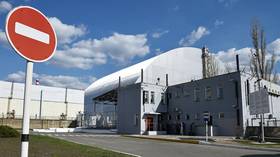Could Chernobyl blow again? Scientists working at site of nuclear disaster detect rise in fission reactions inside abandoned plant

Thirty-five years ago, reactor 4 at the Chernobyl power plant in the then-Soviet Union exploded, causing the world’s worst nuclear accident. Now, scientists have discovered smoldering reactions deep inside the abandoned facility.
People working on the site, in northern Ukraine, are now trying to determine whether the fission will slow down on its own, or whether an intervention needs to be planned. The reactions are taking place in a room sealed with concrete, and getting inside would be no simple task.
Last week, Anatoly Doroshenko of Kiev’s Institute for Safety Problems of Nuclear Power Plants (ISPNPP) reported a 40% rise in neutron emissions since 2016. The acceleration in reaction has been described by University of Sheffield professor Neil Hyatt as “embers in a barbecue pit,” and a “reminder to us that it’s not a problem solved, it’s a problem stabilized.”
Also on rt.com 35 years after nuclear reactor explosion, Ukraine announces plan to build museum & recreational spaces in Chernobyl Exclusion Zone“We have seen excursions like this before with other fuel debris,” he told magazine New Scientist. “The neutron base rate has increased, stabilized and decreased again. That's obviously what we hope might happen.”
However, if the situation doesn't resolve itself, Doroshenko and his team may have to make a plan to solve the problem. A solution might involve drilling into the chamber itself, which is currently inaccessible and hasn't been seen by humans since the disaster.
One of his ISPNPP colleagues, Maxim Saveliev, has advocated sending in robots to get a clearer picture of what is going on.
Also on rt.com Radioactive shrooms?! Ukraine arrests two men for picking bucketloads of fungi in Chernobyl’s nuclear exclusion zoneWhile nobody is quite sure what is causing the spike in reactions, some have suggested that the construction of a new structure over the reactor may be to blame. When the plant melted down on 26 April 1984, it was covered rapidly with a makeshift sarcophagus. Its replacement was started in 2010, and covered the reactor in 2016. While the old construction was full of holes and allowed rainwater in, the newly built structure is much more secure and airtight. The lack of moisture could mean that there is no longer enough water to slow neutrons down.
In recent years, Chernobyl has become a tourist attraction. Last month, Kirill Timoshenko, the deputy head of Ukraine's Presidential Office, revealed plans to build a new recreational zone, including a museum, and pledged extra money for repairing roads to improve access for visitors and scientists.
If you like this story, share it with a friend!













